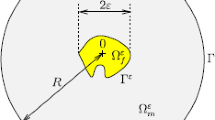Abstract
By passing to the limit in the general solution, we obtain several exact asymptotic formulas for the energy of an inhomogeneity in a body located in an external stress field. The parameters determining the type of the asymptotic behavior are the inclusion semiaxis ratio and the inclusion-matrix elastic modulus ratio. In the case of a large simultaneous deviation of the parameters from unity, we distinguish seven regions corresponding to various successive passages to the limit as these parameters approach zero (or infinity).
Similar content being viewed by others
References
J. D. Eshelby, “The Determination of the Elastic Field of an Ellipsoidal Inclusion, and Related Problems,” Proc. Roy. Soc. London. Ser. A 241(1226), 376–396 (1957).
J. D. Eshelby, “Elastic Inclusions and Inhomogeneities,” in Progress in Solid Mechanics, Vol. 2, Ed. by I. N. Sneddon and R. Hill (North-Holland, Amsterdam, 1961), pp. 89–140.
T. Mura, Micromechanics of Defects in Solids (Martinus Nijhoff Publ., Hague, 1982).
J. R. Bristow, “Microcracks and the Static and Dynamics Elastic Constants of Annealed and Heavily Coldworked Metals,” British J. Appl. Phys. 11, 81–85 (1960).
R. L. Salganik, “Mechanics of Bodies with Many Cracks,” Izv. Akad. Nauk SSSR. Mekh. Tverd. Tela, No. 4, 149–158 (1973) [Mech. Solids (Engl. Transl.) 8 (4) 135–143 (1973)].
T. T. Wu, “The Effort of Inclusion Shape on the Elastic Moduli of a Two-Phase Material,” Int. J. Solids Struct. 2, 1–8 (1966).
Yu. F. Kovalenko and R. L. Salganik, “Fractured Inhomogeneities and Their Influence on Effective Mechanical Characteristics,” Izv. Akad. Nauk SSSR. Mekh. Tverd. Tela, No. 5, 76–86 (1977) [Mech. Solids (Engl. Transl.)].
R. L. Salganik, “Transport Processes in Bodies with a Large Number of Cracks,” Inzh. Fiz. Zh. 27(6), 1069–1075 (1974) [J. Engng Phys. Thermophys. (Engl. Transl.) 27 (6), 1534–1538 (1974)].
W. B. Russel and A. Acrwos, “On the Effective Moduli of Composite Materials: Slender Rigid Inclusions at Dilute Concentrations,” ZAMP 23(3), 434–463 (1972).
W. B. Russel, “On the Effective Moduli of Composite Materials: Effect of Fiber Length and Geometry at Dilute Concentrations,” ZAMP 24(4), 581–600 (1973).
I. Sevostianov and M. Kachanov, “Compliance Tensors of Ellipsoidal Inclusions,” Int. J. Fract. 96(1), L3–L7 (1999).
K. B. Ustinov and R. V. Goldstein, “On Application of Classical Eshelby Approach to Calculating Effective Elastic Moduli of Dispersed Composites,” Int. J. Fract. 147(1–4), 55–66 (2007).
L. J. Walpole, “On the Overall Elastic Moduli of Composite Materials,” J. Mech. Phys. Solids 17(4), 235–251 (1969).
S. G. Lekhnitskii, Theory of Elasticity of an Anisotropic Body (Nauka, Moscow, 1977; Mir Publishers, Moscow, 1981).
Author information
Authors and Affiliations
Corresponding author
Additional information
Original Russian Text © K.B. Ustinov, 2010, published in Izvestiya Akademii Nauk. Mekhanika Tverdogo Tela, 2010, No. 2, pp. 103–113.
About this article
Cite this article
Ustinov, K.B. Computation of the energy of an inhomogeneity: Asymptotics and their scope. Mech. Solids 45, 238–246 (2010). https://doi.org/10.3103/S0025654410020093
Received:
Published:
Issue Date:
DOI: https://doi.org/10.3103/S0025654410020093



